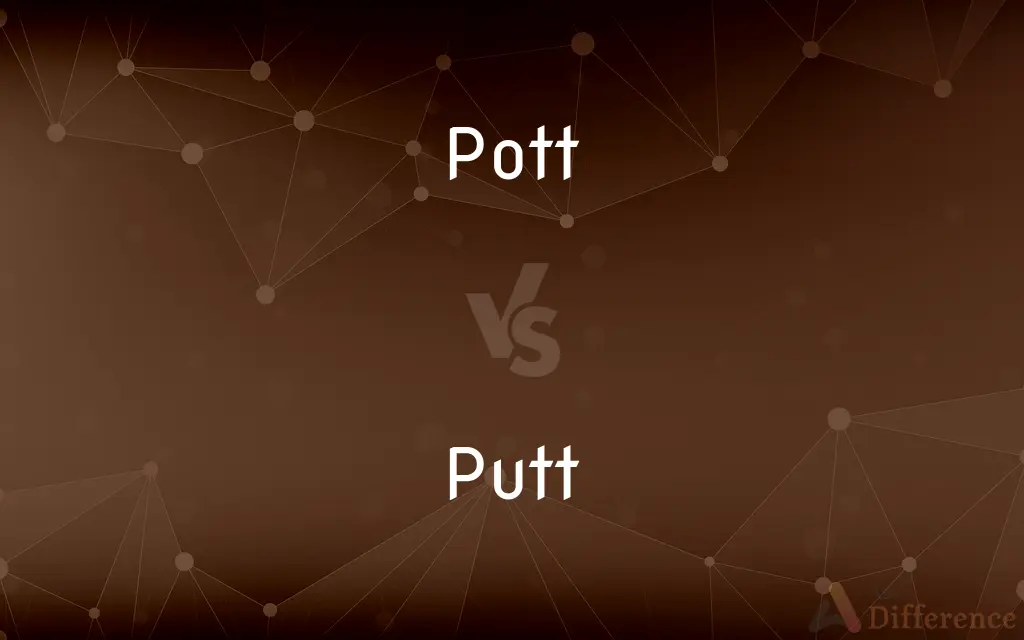Pott vs. Putt — What's the Difference?
Edited by Tayyaba Rehman — By Fiza Rafique — Updated on April 4, 2024
Pott refers to a type of shot in cue sports, aimed at sending a ball into a pocket, while putt is a golf term for a gentle stroke that rolls the ball into the hole.

Difference Between Pott and Putt
Table of Contents
ADVERTISEMENT
Key Differences
Pott is a term specifically used in cue sports like snooker, pool, or billiards, where the objective is to strike a ball so accurately that it falls into one of the table's pockets. This action requires precision and control, as the player must calculate the angle and force necessary to successfully pott the ball. On the other hand, putt is used exclusively in golf, denoting a light, controlled stroke made on the green with the intention of rolling the ball into the hole. Unlike pott, which can involve significant force and strategic positioning around a table, putting requires gentle finesse to navigate the contours and slopes of the green.
In terms of equipment, to pott a ball in cue sports, players use a cue stick, which can vary in weight and size to suit the player's style and the specific game being played. For putting in golf, a putter is used, which is a type of club designed with a flat face to give the player maximum control over the speed and direction of the ball. While both sports require precision, the tools and techniques involved in executing a successful pott or putt are distinct.
The environment plays a crucial role in both terms. Pott takes place on a billiards, snooker, or pool table, where factors like the cloth's texture, table size, and pocket design can influence the shot. In contrast, putting occurs on a golf course's green, where the grass's length, terrain undulations, and weather conditions can affect the ball's path. Players of both sports must adapt to these conditions to be successful.
The strategic importance of a pott and a putt can determine the outcome of a game. In cue sports, potting balls is essential for scoring and can involve setting up for subsequent shots or defensively preventing the opponent from having a favorable position. In golf, putting is often the culmination of a hole, requiring a deep understanding of the green's nuances and precision to finish with the fewest strokes possible.
While both pott and putt are critical skills in their respective sports, the culture and terminology surrounding each are unique. Cue sports often involve terminology related to the physics of the shot, such as "spin" and "angle," while golfing terms frequently address the green's topography, like "break" and "lie."
ADVERTISEMENT
Comparison Chart
Definition
A shot in cue sports aimed at sending a ball into a pocket.
A gentle stroke in golf that rolls the ball into the hole.
Sport
Cue sports (snooker, pool, billiards).
Golf.
Required Skill
Precision and strategic planning.
Finesse and understanding of the green.
Equipment
Cue stick.
Putter.
Environment
Billiards, snooker, or pool table.
Golf course's green.
Strategic Importance
Essential for scoring and positioning.
Culminates a hole, requiring precision.
Compare with Definitions
Pott
A successful shot in snooker.
He lined up the shot and managed to pott the black ball.
Putt
Critical on the green.
Her ability to read the green made her putt seem effortless.
Pott
Strategic play in billiards.
His strategy was to pott the balls in a sequence that set him up for victory.
Putt
The final stroke on many holes.
After a long approach, all that was left was a short putt for birdie.
Pott
Part of the game's lexicon.
Learning how to effectively pott is fundamental to mastering cue sports.
Putt
Integral to golf strategy.
Good putting can compensate for earlier shots, turning a potential bogey into par.
Pott
In pool, sinking a ball into one of the table's pockets.
She took careful aim and potted the eight ball to win.
Putt
A light stroke in golf aiming to get the ball into the hole.
With a steady hand, he made the putt and secured the win.
Pott
A demonstration of precision.
The player's ability to consistently pott from difficult angles impressed everyone.
Putt
Requires specific clubs.
Golfers often have a favorite putter specially chosen for its feel and performance.
Pott
An old size of paper, 12.5 × 15 inches.
Pott paper
Putt
A light golf stroke made on the putting green in an effort to place the ball into the hole.
Pott
A size of paper. See under Paper.
Putt
To hit (a golf ball) with a light stroke on the green.
Putt
To putt a golf ball.
Putt
(golf) The act of tapping a golf ball lightly on a putting green.
Putt
(onomatopoeia) A regular sound characterized by the sound of "putt putt putt putt...", such as made by some slowly stroking internal combustion engines.
Putt
A motorcycle.
Putt
(golf) To lightly strike a golf ball with a putter.
Putt
To make a putting sound.
Putt
To ride one's motorcycle, to go for a motorcycle ride.
Putt
To move along slowly.
Putt
A stroke made on the putting green to play the ball into a hole.
Putt
To make a putt.
Putt
Hitting a golf ball on the putting surface with a putter;
His putting let him down today
Putt
Strike (a golf ball) lightly, with a putter;
He putted the ball several feet past the hole
Putt
: hit a putt;
He lost because he putted so poorly
Common Curiosities
How does one improve their putting in golf?
Practice, understanding the green's topography, and choosing the right putter can significantly improve putting.
Can the equipment used affect a player's ability to pott or putt?
Yes, the choice of cue stick or putter can impact a player's precision and comfort, influencing their performance.
What's the importance of the environment in pott and putt?
The surface and conditions of the play area (table or green) can greatly affect the success of pott or putt attempts.
How do pott and putt contribute to their respective games?
Both are crucial for scoring, with potting necessary for cue sports and putting often determining the score on a golf hole.
What skills are needed to pott in snooker?
Precision, control, and strategic foresight are key to successfully potting balls.
How do beginners learn to pott or putt?
Through practice, coaching, and observing skilled players, beginners can develop their potting and putting skills.
Do pott and putt have different rules in their sports?
Yes, the rules governing how a ball is potted or putted vary between cue sports and golf, reflecting each sport's unique challenges.
How do professionals enhance their pott or putt?
Professionals continuously refine their technique, use high-quality equipment, and study their sport's physics to improve.
Can weather affect a putt in golf?
Absolutely, wind and rain can alter the green's speed and the ball's path, making putting more challenging.
What common mistakes do beginners make with pott and putt?
Common mistakes include improper alignment, incorrect force application, and lack of strategic planning.
What's the role of technique in potting and putting?
A solid technique is foundational, affecting accuracy, consistency, and the ability to adjust to different conditions.
Can technology aid in improving putt or pott skills?
Yes, technology like simulations, video analysis, and equipment advancements can help players analyze and enhance their techniques.
How do pott and putt reflect a player's overall skill level?
Mastery of these skills is often a good indicator of a player's proficiency and understanding of the game.
Is there a psychological aspect to successful potting or putting?
Yes, confidence and mental focus are important for both, as they require precision under pressure.
Are there competitions focused solely on putting or potting?
While most competitions incorporate these as part of the overall game, there are putting competitions in golf, showcasing the skill's importance.
Share Your Discovery

Previous Comparison
Picture vs. Plan
Next Comparison
Registry vs. RegistrarAuthor Spotlight
Written by
Fiza RafiqueFiza Rafique is a skilled content writer at AskDifference.com, where she meticulously refines and enhances written pieces. Drawing from her vast editorial expertise, Fiza ensures clarity, accuracy, and precision in every article. Passionate about language, she continually seeks to elevate the quality of content for readers worldwide.
Edited by
Tayyaba RehmanTayyaba Rehman is a distinguished writer, currently serving as a primary contributor to askdifference.com. As a researcher in semantics and etymology, Tayyaba's passion for the complexity of languages and their distinctions has found a perfect home on the platform. Tayyaba delves into the intricacies of language, distinguishing between commonly confused words and phrases, thereby providing clarity for readers worldwide.















































